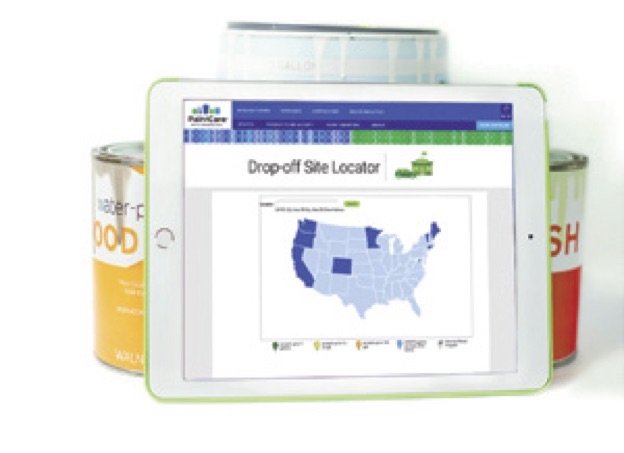2021
Annual Report
Message from the President
Dear Members,
I am pleased to report that 2021 was another successful year for ACA. Our 2021 Annual Report showcases many of the association’s achievements and activities of the past year.
The report highlights areas where ACA provided support and engaged on behalf of the industry:
- Targeted Federal & State Advocacy
- Member Webinars & Compliance Resources
- Sustainability & Green Building
- PaintCare Program
These focal points align with the association’s mission to support our members as they navigate through multiple challenges and ever more complex compliance obligations while seeking to reduce the burden from new and often unnecessary regulation and legislation. At the same time, ACA continues to promote our industry’s commitment to environmental protection and product stewardship.
The final section in the Annual Report, the “Additional Accomplishments,” underscores the breadth of ACA’s engagement in 2021, and the marked successes of its concerted efforts.
Undoubtedly, 2022 will bring additional challenges and opportunities; your support makes it possible for ACA to meet them, and we thank you. We look forward to continuing our work together, ensuring the welfare and advancement of America’s paint and coatings industry.
![]()
Andy Doyle
American Coatings Association
CEO & President

Targeted Federal & State Advocacy
In 2021, ACA targeted its strategic advocacy at the national and state level on issues impacting the industry to best represent the industry’s interests.
ACA Petitions Yield EPA Action
National Aerosol Rule
 In September 2021, the U.S. Environmental Protection Agency (EPA) published a proposal to amend the National Volatile Organic Compound (VOC) Emission Standards for Aerosol Coatings, which establishes reactivity-based emission standards for the aerosol coatings category (aerosol spray paints) under the Clean Air Act. ACA has sought this EPA action for more than four years, filing three petitions for rulemaking with the agency and engaging in repeat advocacy to persuade EPA to revise the national rule for consistency with California’s aerosol coatings rule.
In September 2021, the U.S. Environmental Protection Agency (EPA) published a proposal to amend the National Volatile Organic Compound (VOC) Emission Standards for Aerosol Coatings, which establishes reactivity-based emission standards for the aerosol coatings category (aerosol spray paints) under the Clean Air Act. ACA has sought this EPA action for more than four years, filing three petitions for rulemaking with the agency and engaging in repeat advocacy to persuade EPA to revise the national rule for consistency with California’s aerosol coatings rule.
EPA’s proposed amendments align with most of what ACA had asked for on behalf of industry. The agency is proposing to update the product- weighted reactivity limits by coatings category; revise the maximum incremental reactivity (MIR) values for several aerosol coatings compounds; add new compounds and reactivity factors; revise the default reactivity value; amend the thresholds for compounds already regulated by the rule; and add new electronic reporting provisions.
Consistent to its approach for regulation that is achievable and based on sound science, ACA sought the update of a regulatory mandate that is based on the most current and best available science on MIR. In its petitions and outreach to EPA, ACA underscored that reactivity factors of each of the 16 aerosol coatings compounds it asked the agency to add to Table 2A of MIR values have undergone significant scientific study; been peer reviewed by the scientific community; reflect the most up-to-date scientific research available and are widely accepted. Notably, that data underpins the California Air Resources Board (CARB) rule which has also assigned MIR values to these compounds intended to be used by the regulated community.
It’s a major victory that ACA convinced EPA to propose the amendments, and the association will remain engaged in the EPA rulemaking throughout 2022 to ensure a final national rule matches the CARB rule, informed by the most up-to-date and accepted science, to minimize the undue compliance burdens that the divergent regulatory schemes have created for industry.
TSCA Risk Mitigation Procedure
…a framework rule would provide greater certainty to all stakeholders on how EPA will regulate chemicals…
In response to a petition for rulemaking jointly filed by ACA with the National Association of Home Builders, U.S. Chamber of Commerce, Toy Association, and National Association of Manufacturers, U.S. EPA announced it will develop a Toxic Substances Control Act (TSCA) risk management procedural rule.
ACA’s petition for rulemaking filed in June 2020 underscored that TSCA risk management is riddled with myriad uncertainties. While Congress authorizes EPA to select from an array of risk management options in TSCA §6(a), a procedural rule is needed to establish a central point of reference for all requirements and considerations involved in crafting a risk management rule regulating a specific chemical. ACA urged EPA to initiate framework rulemaking within Congressionally mandated parameters, currently found across various provisions of TSCA, in Section 6 and elsewhere.
ACA maintains that a framework rule would provide greater certainty to all stakeholders on how EPA will regulate chemicals that the agency determines to present unreasonable risks, because procedural guardrails are needed to guide EPA as it considers appropriate risk mitigation measures and to help affected stakeholders understand the parameters by which the agency could regulate the evaluated chemicals. Absent such a framework rule, EPA’s risk management actions could be applied inconsistently and be potentially overbroad.
At this writing, EPA had not yet initiated the rulemaking, but the agency published its intent to do so on its Fall 2021 Regulatory Agenda. ACA will represent industry’s perspective and interests to the agency throughout the rulemaking process.
PFAS Efforts
 Per- and polyfluoroalkyl substances (PFAS) are a vaguely defined chemical grouping of fluorinated chemicals used as an additive in wide array of products. With growing public concern about potential hazards of PFAS in drinking water and other sources, lawmakers and regulators across the country have initiated varied programs to evaluate and eventually regulate those substances. Industrial sites are challenged with conducting site remediation and disposal of existing stocks of firefighting foam and products onsite containing PFAS substances from legacy industrial uses.
Per- and polyfluoroalkyl substances (PFAS) are a vaguely defined chemical grouping of fluorinated chemicals used as an additive in wide array of products. With growing public concern about potential hazards of PFAS in drinking water and other sources, lawmakers and regulators across the country have initiated varied programs to evaluate and eventually regulate those substances. Industrial sites are challenged with conducting site remediation and disposal of existing stocks of firefighting foam and products onsite containing PFAS substances from legacy industrial uses.
Over the past year, ACA worked through its PFAS Policy Working Group and relevant committees to inform members of these regulatory and legislative schemes at the national and state level, and to curtail or mitigate any undue burdens on industry in this sphere.
Federal Legislation
ACA worked diligently to prevent the passage of any provision under the federal PFAS Action Act that would designate the whole class of PFAS compounds as hazardous substances under the Safe Drinking Water Act or Comprehensive Environmental Response, Compensation, and Liability Act of 1980 (CERCLA). Currently, PFOA and PFOS are considered pollutants and not hazardous substances. U.S. EPA has authority for response or clean-up only where release may present an imminent and substantial danger to the public.
This troubling provision was muddied further by a last minute en bloc amendment offered on the day of bill voting in the U.S. House of Representatives. The amendment provides EPA with the authority to develop effluent standards guidelines for several priority industries, including the “paint formulating” industry. While the bill passed the House, at this writing, it was under consideration by the Senate, which does not appear receptive to the the House’s more expansive provisions.
ACA has worked collaboratively with the U.S. Chamber of Commerce to defeat the bill’s overly broad provisions and in its advocacy is underscoring to Congress that a unilateral designation of “hazardous” for an entire class of chemicals is inappropriate and that sound science should be applied to each individual chemical to make a determination of hazard and risk. ACA maintains that this should be accomplished by the experts at the EPA under the procedures articulated in TSCA, not by members of Congress.Notably, ACA has pointed to efforts at U.S. EPA under recent TSCA amendments to use existing regulatory programs to review and restrict PFAS chemicals individually, not as a class of chemicals. This includes expanding proposed Significant New Use Rules (SNUR) to cover additional PFAS chemicals and screening any new PFAS chemicals under EPA’s New Chemical Review Program.
The 2021 National Defense Authorization Act (NDAA) is another legislative vehicle with PFAS provisions. ACA worked with a coalition to oppose sweeping PFAS provisions in this bill; however, another last-minute House amendment included provisions to broaden the definition of PFAS and eliminate an exception for Toxic Release Inventory (TRI) reporting for mixtures (following the 2020 NDAA, EPA added 172 PFAS to the TRI list, effective Jan. 1, 2020, requiring reporting by July 2021 for calendar year 2020, when manufactured, imported, processed, or used in amounts above 100 pounds per year).
A Senate version of the NDAA, which does not include the expansive House provisions, was being considered. The final version of the NDAA signed by the president on Dec. 27, 2021, does not include the problematic provisions from the House bill. The bill signed into law included the following: 1) significant funding for PFAS clean up in the military branches, along with $15 million in funding for a human health assessment on PFAS; 2) prohibiting the U.S. Department of Defense from incinerating PFAS; and 3) requiring the Government Accountability Office to audit procurement of any items containing PFAS.
Activity at EPA
In June, U.S. EPA proposed a PFAS Reporting Rule, under the 2020 NDAA. ACA submitted extensive comments to both EPA and the White House Office of Management and Budget raising significant concerns with the PFAS Reporting Rule as proposed. ACA took issue with the rule’s structural PFAS definition to include polymers and articles; lack of a de minimis exemption; the overly broad scope of data submission; the underestimated burden of the “known to or reasonably ascertainable by” standard of due diligence; and the truncated 1-year period open for data submission.
ACA also questioned EPA’s selective reading of TSCA Section 8 to exclude a standard Section 8 exemption for small businesses. ACA also emphasized that as proposed, the rule’s burden on both industry and the agency is grossly underestimated, and that as constructed, the rule will result in reporting of duplicative and outdated information.
In mid-October, the White House released EPA’s PFAS Strategic Roadmap, a three-year plan describing specific regulations with deadlines and research the agency plans to undertake to understand where additional controls may be needed, and a course of action based on evaluation of individual PFAS substances. EPA has stated that it may group substances together based on remediation strategies, relative risk or other criteria when considering regulatory approaches. The roadmap includes the following EPA activities:
- New rules setting final drinking water limits for PFAS to be released by fall 2023. EPA will consider setting final drinking water limits for additional specified PFAS chemicals. EPA will conduct toxicity assessments and develop advisory standards for GenX and other fluorinated chemicals. EPA also plans on developing discharge limits for industry sectors where it has adequate information, while initiating data reviews for industry sectors where little is known about PFAS discharges, including paint formulation, leather finishing and plastic molding;
- A regulation designating specified PFAS as hazardous Superfund substances by spring 2022. Included would be a requirement for industrial and other sites to report PFAS releases at or above the EPA’s set threshold;
- Initiating a new rulemaking in 2022 to modify PFAS listings in the Toxics Release Inventory (TRI). EPA will propose listing them as ‘Chemicals of Special Concern,’ thereby lowering the reporting volume threshold and removing the de minimis exemption;
- Finalizing the PFAS Reporting Rule by January 2023, requiring chemical manufacturers and importers to submit a spectrum of physical characteristics, environmental, and other data needed to understand PFAS; and
- EPA exploration of its existing authorities under TSCA to determine what rules or other actions may be warranted to restrict or reduce the approximately 600 PFAS being used in commerce. Actions under TSCA may include enhanced enforcement of existing restrictions, revision of requirements, and new testing requirements for manufacturers and importers.
ACA will continue to utilize its PFAS Policy Working Group to engage and respond to both federal regulatory and legislative action on PFAS.
State Activity
ACA also monitored PFAS restriction efforts at the state level for industry impact. Several states passed PFAS bills during the 2021 legislative session, including Maine, Connecticut, Nevada, West Virginia, and Illinois. The Connecticut law, S. 837, addressed AFFF firefighting foam as well as food packaging.
In Maine, LD 1503 banned the use of intentionally added PFAS in carpets, rugs, and fabric treatments by 2023. But importantly, by 2030, all products that contain intentionally added PFAS are banned unless a decision has been made by the environmental agency that the use of PFAS was unavoidable. Maine’s law will also require manufacturers to register with the agency and allows the agency to collect fees from manufacturers to support the rulemaking activities as well as a PFAS reduction program.
State EPR Legislation
ACA was able to mitigate further burdens on industry in two states where PaintCare has longstanding programs…
Extender Producer Responsibility (EPR) legislation was prevalent across the states in 2021. The proposals require producers to manage the end-of-life products introduced into commerce, including the products’ packaging as means of reducing the packaging waste stream, and in many cases, shifting the cost burden from state government to industry.
Given ACA and industry’s paint product stewardship program, PaintCare, ACA was able to mitigate further burdens on industry in two states where PaintCare has longstanding programs. ACA’s engagement during the legislative process on bills enacted in Maine and Oregon establishing EPR programs for plastic containers will save the industry potentially millions of dollars in fees that will be assessed annually. While these bills differed in their construct, both would impose significant fees on paint manufacturers and are completely financed by a fee. ACA’s legislative strategy succeeded in incorporating language in both bills that will exempt containers for architectural paint, subject to a paint stewardship program, because of PaintCare operations in both Maine and Oregon.
Moreover, ACA advocacy helped ensure that EPR bills in Oregon (relating to household hazardous waste), Maryland, Vermont, and New York did not pass. ACA worked to negotiate language in these bills that would recognize the work conducted by product stewardship organizations, underscored significant negative impacts on industry and will continue to do so in any emerging EPR legislation.
Federal Infrastructure Legislation

Throughout 2021, ACA focused its federal advocacy on how critical industry’s paint and coatings products are to the national infrastructure. ACA engaged numerous Congressional offices to support legislation that provides for broad-based investment in infrastructure repair and modernization, including increased public and private funding; a state-of-the-art information and telecommunications system; modern road, wastewater and drinking water systems; and improved inland waterways and ports. In doing so, ACA touted the essential role of coatings, the industry, and its employees in the effort to rebuild the nation’s infrastructure and critical public works.
ACA also repeatedly advocated for federal action to address the issue of severe driver shortages in the chemical and coatings industries, including establishment of a pilot program to make more drivers available to the coatings industry. This pilot program was included in the broader infrastructure bill passed by Congress and signed into law by President Biden in November 2021.
Among the pillars of an upgraded infrastructure plan where paints and coatings will have an immediate ameliorating impact is transportation infrastructure. As such, ACA pushed for federal adoption of amendments to the Manual on Uniform Traffic Control Devices (MUTCD) — guidelines for traffic control devices, including road surface markings — which will increase safety while also enabling the future of transportation, including electric vehicles and other technological advancement. This guidance is issued by DOT’s FHA, and ACA strongly supported proposed updates.
The proposed amendments include provisions necessary to update road marking criteria — standardizing lane marking dimensions across the U.S. and eliminating ambiguous conditions with tightened lane marking uniformity. The proposed updates to the MUTCD underscore the need for compatibility with today’s driver assistance and tomorrow’s fully automated driving systems. As autonomous vehicles continue to gain wider adoption, road markings and vehicle coatings will become even more critical to safety, as vehicles read the road and communicate with one another. Innovative solutions such as retroreflective road paint, which directs light toward cars on the road rather than in all directions, will play an important role in driver and passenger safety. Manufacturers that produce such innovative coatings will make significant contributions to advancing safety through continued R&D.
FHA is expected to adopt those critical amendments.
Member Webinars & Compliance Resources
In 2021, ACA expanded its compliance support for members, hosting numerous webinars and providing written guidance and online resources to help members traverse the increasingly crowded and complicated regulatory landscape.
Member Webinars

As part of its Member Webinar Series, ACA hosted some 30 webinars for members, expanding its efforts to bring issues of regulatory, international, and supply-chain import that are topical and impactful to members. The latter was a pressing matter for many coatings companies, as the impact of the pandemic’s disruption of global supply of key raw materials affected many product groups, including pigments, resins, acrylics, solvents, and packaging. Particularly salient webinars with considerable member feedback included:
- Business continuity planning: addressing supply-chain relocations, manufacturing, and business interruptions;
- Coatings raw material supply for 2021 and beyond;
- VOC rulemaking efforts across North America;
- Exempt-VOC regulatory activity in California and elsewhere;
- EU classification of titanium dioxide and compliance considerations;
- Overview of legislative initiatives and regulatory proposals on plastics potentially impacting coatings and the packaging used by coatings products, including microplastic regulations in Europe, Canada, and the United States;
- Biocide reviews in Canada, Europe, and the United States;
- Chemicals management initiatives in the United States; and
- The Cool Roof Rating Council’s Wall Rating Program.
ACA aims to further broaden its webinar offerings in 2022, with presentations planned to address supply chain issues; the National Oceanic and Atmospheric Administration’s reports on VOC emissions from industrial and consumer products; and the Global Cool Cities Alliance efforts to advance urban heat island mitigation.
Compliance Resources
USMCA Rules of Origin
Proper understanding of these rules is crucial to obtaining duty-free treatment for products shipped between North American countries, and documenting claims to such treatment.
At the beginning of the year, ACA issued a new guide for members to help them navigate the Rules of Origin duties under the United States-Mexico-Canada Trade Agreement (USMCA). The USMCA is a regional trade agreement that eliminates barriers in trade and facilitates cross-border movement of goods and services between these three parties. USMCA officially went into force on July 1, 2020, replacing the previous trade agreement, the North American Free Trade Agreement (NAFTA).
The USMCA provides for duty-free trade between signatory countries of goods that would normally be subject to import duties, so long as the goods meet the USMCA’s Rules of Origin. Compliance with these rules means that the goods will be considered “originating” in the territory of the three signatory countries.
The agreement’s product-specific rules of origin must be applied to determine whether goods, including paint and coating products, meet the requirements for originating status. Proper understanding of these rules is crucial to obtaining duty-free treatment for products shipped between North American countries, and documenting claims to such treatment.
ACA’s critical guidance was timely and focused specifically on applying the Rules of Origin, providing examples and explanations for how to apply these rules while engaging in cross-border trade.
ACA Industry Labeling Guide
In the spring, ACA published its long-awaited ACA Industry Labeling Guide, Sixth Edition. The guide provides members at all stages of the supply chain an understanding of requirements and provides general guidance for hazard and precautionary labeling under the principal statutory and regulatory programs applicable to paints, coatings, sealants, adhesives, and related industry products.
ACA updated the guide for its membership in consultation with several association working groups and committees. Developed through industry practice, the guide addresses labeling considerations specific to volatile organic compounds, carcinogens, and more.
Companies placing products on the market may use the guide when developing product labels for products intended for the workplace, consumer markets, or both consumer and industrial/commercial markets.
Following publication, ACA hosted a webinar for members on product labeling and compliance challenges, where it walked members through the updated ACA Industry Labeling Guide, Sixth Edition.

Regulatory Matrices
Additionally, ACA created and maintained the following regulatory guidance resources to support industry’s compliance with the various paint and coatings regulations throughout the United States:
- A map of consumer products regulations;
- A table of marine and pleasure craft coatings regulations;
- A table and map of auto-refinish regulations;
- A table of AIM VOC regulations; and
- A list of industrial adhesives regulations by state and local air district.
These resources are made available to all members via ACA’s issue management committees and are featured on ACA’s website.
Sustainability & Green Building
Guided by its Sustainability Committee, ACA aims to build a comprehensive industry approach to sustainability, focusing on programs and areas that deliver the most value to the industry.
Promoting Powder Coatings
In 2021, ACA expanded its messaging about the inherent sustainable nature of coatings in extending the useful life of products to which they are applied. As part of that focus to highlight the range and variety of sustainable coatings on the dedicated Sustainability section of its website, ACA published “The Sustainability of Powder Coatings.” This document, which can be used as an advocacy tool, showcases the environmental benefits of powder coatings andits sustainable contributions. The document demonstrates powder coatings’ intrinsic environmental advantages, including low Hazardous Air Pollutant emissions, zero VOCs, free of organic solvent demand, and single-coat process.
“The Sustainability of Powder Coatings” underscores the versatility of powder coatings, which can be applied to a variety of products and substrates including metal, plastic, and medium density fiberboard. It also touts the extreme hardness and durability of powder coated products and ability to withstand extreme weather, UV-light exposure, moisture, and erosion, providing better corrosion protection.
Product Category Rules
Following publication of a Product Category Rule (PCR) for Powder Coatings in late 2020, ACA initiated a PCR for Coil Coatings. A PCR provides an agreed-upon framework for measuring environmental impacts of a product based on a defined set of criteria. This allows manufacturers to conduct Life-cycle Assessments (LCAs) on their products in a standardized way and publish this information in an Environmental Product Declaration (EPD) if they so choose.
ACA’s PCRs are important tools that assist members with the publication of verifiable EPDs, and aid members in achieving additional Leadership in Energy and Environmental Design (LEED) credits.
ACA engaged a third-party developer of public health standards certification programs to devise the PCR for Coil Coatings. ACA’s latest PCR will be published in early 2022, complementing its collection of PCRs for Architectural Coatings, Resinous Floor Coatings, and Powder Coatings.
CRRC Wall Product Rating Program
 In 1998, the Cool Roof Rating Council (CRRC) developed a Cool Roof Coating Standard for roof coatings to achieve certain solar reflective value, which resulted in a shift to utilization of light-colored coatings and/or solar reflective engineered pigments. This program has been widely adopted into various building codes and Green Building standards in much of the United States.
In 1998, the Cool Roof Rating Council (CRRC) developed a Cool Roof Coating Standard for roof coatings to achieve certain solar reflective value, which resulted in a shift to utilization of light-colored coatings and/or solar reflective engineered pigments. This program has been widely adopted into various building codes and Green Building standards in much of the United States.
Over the last couple of years CRRC has undertaken development of a Wall Product Rating Program. Like the Cool Roof Rating Program, the Wall Product Rating Program will rate exterior wall products based on the surface radiative properties such as solar reflectivity and thermal emittance levels. ACA sits on CRRC’s Wall Product Rating Program Board Committee and Technical Committee, and over the past year, provided the council technical input to ensure the program requirements are achievable for industry.
ACA advocated for accurate and achievable testing measures for the testing of solar reflectivity and thermal emittance levels for architectural wall coatings. With ACA support, CRRC’s Wall Product Rating Program will launch in 2022.
ACA has also created a Solar Reflectivity work group to keep industry informed, solicit input about technical aspects of the program, and address any upcoming changes to Green Building codes focused on this issue.
ACA’s PaintCare program continues to prove the paint industry as a national leader in terms of comprehensive, consistent, and effective manufacturer-led product stewardship. ACA launched the end-of-life management program for post-consumer paint in 2009, and has since implemented program operations in Oregon, California, Connecticut, Rhode Island, Vermont, Minnesota, Maine, Colorado, the District of Columbia, and Washington state, with a new program under development in New York expected to start in May 2022.
Resilience & Return
At the start of 2021, PaintCare’s services were once again fully operational following an uneven 2020 and the COVID-19 pandemic’s continuing effects. It is a testament to the strong foundation of the or- ganization laid over its first decade that PaintCare was able to navigate the challenges of 2020 — site closures, restrictions on staff movement, volatile markets, service disruptions — and come out stron- ger. In April 2021 PaintCare launched a statewide program in Washington state; in May the number of PaintCare drop-off sites nationwide crossed the 2,000 mark; and in July the program reached another astounding milestone: 50,000,000 gallons of post-consumer paint responsibly managed.
PaintCare reached new heights over the last year in each of its service areas. The program held more than 265 paint collection events in underserved areas and managed paint from more than 5,750 house- hold hazardous waste (HHW) events to date. PaintCare also performed more than 5,500 large-volume pickups (LVP) for businesses and households. In fact, in 2021 the program expanded the LVP service to a broader audience by lowering its eligibility minimum from 200 gallons to 100 gallons.
And the successes of the industry-led stewardship program continue to attract notice. The California Resource Recovery Association gave PaintCare its 2021 award for Outstanding Household Hazardous Waste, Universal, Electronic Recycling Program in recognition of its significant contribution to waste reduction efforts in the most populous U.S. state.
11
Statewide paint stewardship laws have been passed in the United States
5,000+
Large-Volume Pickups
50 Million+
Gallons of post- consumer paint collected to date
75%
Paint collected is latex (water-based) paint, the remainder is solvent- based paint
600,000
Gallons of paint collected each month in nine programs (estimate)
2,000+
Year-Round Paint Drop-off Sites
5,600+
HHW and other events, including 250 PaintCare-run events
98%
PaintCare maintains year-round sites within 15 miles of 98% of the combined populations of its program state
Millions of dollars saved annually for local and state governments!
Growth & Opportunity
PaintCare continued to expand in 2021. The organization successfully launched a new program in Washington state on March 1, establishing nearly 200 drop-off sites for households and businesses in the first six months of operation. Meanwhile, work is underway to launch the next program in May 2022 in New York, which will be PaintCare’s second most populous state. PaintCare has submitted a preliminary program plan to its oversight agency, the New York State Department of Environmental Conservation, hired local staff, and begun recruitment of drop-off sites.
ACA also continued to develop inroads in other new states, with a long-view strategy to engage with the state legislators to increase understanding of product stewardship and become champions of PaintCare legislation. In 2021, ACA shepherded paint stewardship legislation in New Jersey, Massachusetts, Illinois, and Maryland.
In New Jersey, paint stewardship legislation was reintroduced after being vetoed by the governor in late 2020. However, the bill once again received a positive response in 2021 committee hearings. Clarifying language has been added to the bill text that is designed to respond to the governor’s concerns and the legislation is well-positioned for new action during the upcoming session.
In Massachusetts, legislation was re-introduced in early February. With some updated language, the 2021 bill is basically the same as a previous version. With no opposition testimony at recent committee hearings, the legislation has a strong chance at progress as Massachusetts works through the first year of a two-year session.
Paint stewardship bills in Illinois and Maryland did not break through in 2021. A paint stewardship bill introduced in Illinois in March was backed by strong testimony on the details and operation of the program, however questions were raised about the PaintCare fee and the program benefits leading to the bill being removed from the agenda without a vote. The bill sponsor pledged to work with stakeholders to respond to the members’ questions.
In Maryland, there was no opposition to the bill from stakeholders at committee hearings, including the retail organization, and it had the support of many counties and environmental groups including the Sierra Club. Since a similar bill passed the House of Delegates in 2020, Del. Regina Boyce was able to expedite passage in her chamber this year and have the bill transferred quickly to the Senate. In the Senate, the bill passed the committee hearing expeditiously due to a truncated COVID-19 schedule and was presented on the Senate floor. At the last possible moment, questions were raised about the PaintCare fee, and the bill was tabled with no vote. In preparation for the 2022 session, ACA is seeking a Senate sponsor to workalongside Del. Boyce and, hopefully, to eliminate the questions raised on the Senate floor.
ACA will continue to pursue programs in these states and others, working to help lawmakers and stakeholders to fully understand the program and its benefits.
ACA also worked in 2021 to protect state programs already in place. ACA was again successful in convincing the Rhode Island Senate to reject a bill that would have required the oversight agency to allow for public bids to operate the paint stewardship program. And in Connecticut, ACA convinced legislators to forgo any legislation that would negatively impact the program’s funding mechanism or the retail network of collection sites.


Additional Accomplishments
The association achieved success with other key industry-related efforts in 2021.

Clean Air
ACA convinced California’s Ventura County Air Pollution Control District and Mojave Desert Air Quality Management District to align their industrial adhesive and sealant rules with neighboring air district regulations and include sell-through and use-by provisions. ACA’s advocacy effort ensures consistency in industrial adhesive and sealant rules throughout the state.
ACA secured a one-year extension of the compliance date for the New York State Department of Environmental Conservation’s (NYSDEC) AIM rule, giving industry additional time to reformulate to meet new VOC limits.
ACA convinced NYSDEC to align its final amended rule for consumer products with the Ozone Transport Commission (OTC) Phase IV Model Rule and include a reasonable compliance date. ACA’s advocacy effort ensures an improved level of consistency in consumer product rules throughout the Northeast OTC region.
ACA’s work on the National Emissions Inventory led to U.S. EPA lowering the emission inventory for AIM coatings by 20 percent, which will minimize future state actions to further lower AIM VOC emissions.
ACA convinced California’s San Diego Air Quality Management District to include a longer compliance timeframe and to not adopt the South Coast Air Quality Management District’s Small Container Exemption contingency measure restrictions for Rust Preventatives and Industrial Maintenance Coatings.
ACA persuaded Arizona’s Maricopa County Air Quality Department to adopt provisions in its industrial adhesives rule that are consistent with U.S. EPA’s Control Technique Guideline (CTG) for Miscellaneous Industrial Adhesives.
ACA convinced Kentucky’s Louisville Metro Air Pollution Control District to adopt provisions consistent with U.S. EPA’s Risk Management Program (RMP) rule.


Chemicals Management Efforts
ACA successfully advocated for a limited exemption from U.S. EPA’s ban on PIP (3:1, or phenol, isopropylated phosphate 3:1) under a congressional mandate to restrict persistent, bioaccumulative and toxic chemicals via amendments to the Toxic Substances Control Act (TSCA). As a result, EPA adopted a limited exemption to the ban for PIP (3:1), which is used as an intermediate in formulation of adhesives and sealants.
ACA convinced the Washington State Department of Ecology to narrow the scope of the Safer Products Program in development from all coatings to a far more limited list of specific paints: architectural paint, spray paint, road paint, and children’s paint.
Under the direction of ACA’s Preservation Product Stewardship Working Group, the association completed a second life-cycle assessment of paint preservatives that documents how they are critical, especially for water-based coatings. The results were published in CoatingsTech magazine’s Green Coatings and Sustainability Issue and highlighted that such preservatives play an important role in coating formulation; how overall product performance must be considered when making formulation changes; and that substitutions without considering the impact on product efficacy can greatly increase the environmental burden of the product.

Environment
ACA commissioned a comprehensive literature review to identify the scientific knowledge of possible coatings-related microplastics. The goal is to understand and quantify the potential release of microplastics from industry products more definitively. The results of the review aim to bolster ACA’s advocacy position for industry in this sphere where academic researchers and institutions have made indefinite connections between the two.
ACA persuaded U.S. EPA to issue a less burdensome permit relating to the agency’s National Pollutant Discharge Elimination System Multi-Sector General Permit for stormwater discharges associated with industrial activity.
ACA worked with U.S. EPA on its registration review of tralopyril (Econea), persuading the agency to continue to allow registration of marine coatings products containing this substance, and averting more stringent controls on its use.
ACA secured consistent and reasonable VOC limits and regulatory requirements in the Arizona Maricopa County Air Quality Department pleasure craft coatings rule, which aligns with U.S. EPA’s CTG for Pleasure Craft Coatings.
ACA convinced the Chemical Safety and Hazard Investigation Board to limit the amount and scope of information that it can request after an accidental release under the final accidental release reporting rule.

State Legislative Advocacy
In Maryland, ACA defeated a bill that would have allowed community associations to seek judicial relief for nuisance abatement in Baltimore County. As a result of ACA’s efforts, the bill did not progress out of committee. This bill would have significantly broadened the universe of parties who could bring a public nuisance action, perverting fundamental tort law.
Also in Maryland, ACA defeated a bill that would have prohibited selling or offering for sale coal tar pavement products or applying coal tar pavement products to a pavement or a similar surface. ACA submitted testimony opposing this proposal and worked with other allied industries to ensure that the proposal was not successful.
Green Building & Sustainability
ACA made substantial progress toward the development of a third-party, multi-attribute Architectural Coating Sustainability program to be incorporated into the U.S. Green Building Council’s Leadership in Energy and Environmental Design (LEED) program through pilot credit 112. This program would allow members to achieve maximum credits under LEED by streamlining testing requirements and help mitigate problematic green building standards and building codes that were developed without industry input.
ACA commissioned research to study how containers used in the architectural, auto refinish, aerosol and light industrial coatings sectors are being managed in the United States. This effort aims to identify the barriers and opportunities for increasing the recycling of these empty containers.

International Affairs
 ACA is shepherding work on the World Coatings Council’s initial Global Coatings Sustainability Report that will include Materiality Analysis, contributions to UN Sustainable Development Goals (SDGs), and sustainability best practices from the council’s association member companies.
ACA is shepherding work on the World Coatings Council’s initial Global Coatings Sustainability Report that will include Materiality Analysis, contributions to UN Sustainable Development Goals (SDGs), and sustainability best practices from the council’s association member companies.
ACA collaborated with its Mexican counterpart, ANAFTPYT, submitting comments on Mexico’s Architectural Coatings regulation currently under development. ACA is seeking to ensure the regulation is reasonable for industry and consistent with standards in neighboring jurisdictions.
Following the European Commission’s final February 2020 regulation classifying titanium dioxide containing greater than 1 percent respirable dust content by inhalation as a Category 2 [Animal] Carcinogen, ACA mobilized to intervene in support of legal action filed by the Titanium Dioxide Manufacturers Association, challenging the legality of the classification and seeking to nullify that regulatory designation. ACA’s intervention is jointly pursued with its European colleagues, the European Council of the Paint, Printing Ink and Artists’ Colours Industry (CEPE) and the British Coatings Federation (BCF). A ruling by the EU Court is not expected until the second half of 2022. ACA has long engaged in the process leading up to the classification maintaining that there is no reliable, acceptable, or available data to suggest that titanium dioxide causes cancer.
Working through the World Coatings Council’s Anti-Fouling Coordinating Committee (AFCC), ACA managed efforts to ensure that the International Maritime Organization’s (IMO) addition of cybutryne to Annex 1 of the International Convention on the Control of Harmful Anti-fouling Systems on Ships (AFS Convention) is reasonable and appropriate for industry. Notably, ACA and the World Coatings Council secured updated effective dates on the controls for cybutryne. The final amendments that were adopted in June 2021 align with the organizations’ objectives. The AFCC also submitted two working documents accepted by the IMO and included on the discussion agenda to: (1) clarify what the IMO and member states should do and consider before deciding to add a substance to Annex 1 of the AFS Convention; and (2) promote consistent survey and certification requirements under the AFS Convention.
ACA and the World Coatings Council submitted seven sets of comments to the IMO’s Correspondence Group on the Review of the 2011 Biofouling Guidelines. Several of ACA’s recommendations were included in the correspondence group’s interim final report to the IMO.


Transportation
ACA convinced the U.S. Department of Transportation’s Pipeline and Hazardous Materials Safety Administration (PHMSA) to issue a final rule that amends the federal Hazardous Materials Regulations (HMR) by incorporating over 20 petitions for rulemaking submitted by the regulated community. The final rule updates, clarifies, and provides relief from various regulatory requirements without adversely affecting safety.
ACA worked with PHMSA on a rulemaking to harmonize the HMR with international standards, which resulted in a proposed rule that will maintain alignment with international regulations and standards by incorporating various HMR amendments, including changes to proper shipping names; hazard classes; packing groups; special provisions; packaging authorizations; air transport quantity limitations; and vessel stowage requirements.
Science & Technology
ACA held its 2021 CoatingsTech Conference in Pittsburgh at the end of June, which was a great industry success. The conference featured 30 technical presentations, three short courses, a keynote address from Carnegie Mellon University’s Dr. Kurt Olson, and the Mattiello Lecture from Arkema’s Dr. Wenjun Wu. Over 100 participants attended, making the conference the first ACA in-person event since the start of the pandemic. The technical conference featured a two-day, multi-track concurrent format whereby attendees customized their conference schedules and experiences, choosing from 25+ technical sessions covering six topic areas: Novel Applications; Analytic Methods/VOC; Test Methods; Biobased Materials; Resin Technology I; Resin Technology II; and Industry Innovation.
The Journal of Coatings Technology and Research (JCTR), ACA’s scientific research journal, marked a notable success: publisher Springer Nature documented that JCTR’s Impact Factor — a widely accepted measure of a journal’s effectiveness — increased from 1.8515 to 2.382, which is considered significant by scholarly publication standards.


